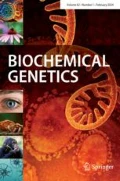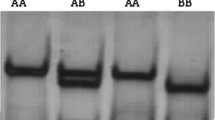Abstract
Myogenic differentiation 1 (MyoD1) genes belong to the MyoD gene family and play key roles in growth and muscle development. This study was designed to investigate the effects of variants in the MyoD1 gene on duck growth and carcass traits. Three duck populations (Cherry Valley, Jingjiang, and Muscovy) were sampled, their growth and carcass traits were measured, and they were genotyped using the PCR–RFLP method. The results showed one novel polymorphism, an alteration in intron 2 of the MyoD1 gene (A to T). It was associated with the traits of weight at 8 weeks, carcass weight, breast muscle weight, leg muscle weight, eviscerated percentage, percentage of leg muscle weight, dressing percentage, and lean meat percentage. This alteration in intron 2 of MyoD1 may be linked with potential major loci or genes affecting some growth and carcass traits.


Similar content being viewed by others
References
Berkes CA, Tapseett SJ (2005) MyoD and the transcriptional control of myogenesis. Semin Cell Dev Biol 16:585–595
Bhuiyana MSA, Kimb NK, Chob YM, Yoonb D, Kimc KS, Jeond JT, Lee JH (2009) Identification of SNPs in MYOD gene family and their associations with carcass traits in cattle. Livest Sci 126:292–297
Cieslak D, Kuryl J, Kapelanski W, Pierzchala M, Grajewska S, Bocian M (2002) Relationship between genotypes at MYOG, MYF3 and MYF5 loci and carcass meat and fat deposition traits in pigs. Anim Sci Pap Rep 20:77–92
Dybus A, Grzesiak W (2006) GHRH/HaeIII gene polymorphism and its associations with milk production traits in Polish Black-and-White cattle. Arch Tierz Dummerstorf 49:434–438
Edmondson DG, Olson EN (1989) A gene with homology to the myc similarity region of MyoD1 is expressed during myogenesis and is sufficient to activate the muscle differentiation program. Genes Dev 3:628–640
Goliasova E, Wolf J (2004) Impact of the ESR gene on litter size and production traits in Czech Large White pigs. Anim Genet 35:293–297
Groeneveld LF, Lenstra JA, Eding H, Toro MA, Scherf B, Pilling D, Negrini R, Finlay EK, Jianlin H, Groeneveld E, Weigend S (2010) Genetic diversity in farm animals: a review. Anim Genet 41(Suppl 1):6–31
Jedrzejczak M, Szatkowska I, Zych S, Grzessiak W, Czerniawska-Piatkowska E, Dybus A (2006) Evaluation of associations of the polymorphism in the placenta specific promoter 1.1 of the CYP19 gene in Black-and-White and Jersey cattle with milk production traits. Arch Tierz Dummerstorf 49:311–314
Knoll A, Nebola M, Dvorak J, Cepica S (1997) Detection of a DdeI PCR RFLP within intron 1 of the porcine MYOD1 (MYF3) locus. Anim Genet 28:321
Liu M, Peng J, Xu DQ, Zheng R, Li PE, Li JL, Zuo B, Lei MG, Xiong YZ, Deng CY, Jiang SW (2008) Association of MYF5 and MYOD1 gene polymorphisms and meat quality traits in Large White × Meishan F2 pig populations. Biochem Genet 46:720–732
Pawel U, Jolanta K (2004) New SNPs in the coding and 5′ flanking regions of porcine MYOD1 (MYF3) and MYF5 genes. J Appl Genet 45(3):325–329
Rothschild MF, Soller M (1997) Candidate gene analysis to detect traits of economic importance in domestic livestock. Probe 8:13–20
Rudnicki MA, Schnegelsberg PN, Stead RH, Braun T, Arnold HH, Jaenisch R (1993) MyoD or Myf-5 is required for the formation of skeletal muscle. Cell 75:1351–1359
Te Pas MFW, Soumillion A, Harders FL, Verburg FJ, Bosch TJ, van den Galesloot P, Meuwissen THE (1999) Influences of myogenin genotypes on birth weight, growth rate, carcass weight, backfat thickness and lean weight of pigs. J Anim Sci 77:2352–2356
Verner J, Humpolicek P, Knoll A (2007) Impact of MYOD family genes on pork traits in Large White and Landrace pigs. J Anim Breed Genet 124:81–85
Wyszynska-Koko J, Pierzchala M, Flisikowski K, Kamyczek M, Rozycki M, Kuryl J (2006) Polymorphisms in coding and regulatory regions of the porcine MYF6 and MYOG genes and expression of the MYF6 gene in longissimus dorsi versus production traits in pigs. J Appl Genet 47:131–138
Wyszynska-Koko J, Pierzchala M, Urbanski P, Blicharski T (2007) Allele frequency of chosen candidate genes of a MyoD family and somatotropin axis in two groups of Polish Landrace and Polish Large White pigs of a high and low meatiness. Arch Tierz 50:35–43
Yin HD, Zhang ZC, Lan X, Zhao XL, Wang Y, Zhu Q (2011) Association of MyF5, MyF6 and MyoG gene polymorphisms with carcass traits in Chinese meat type quality chicken populations. J Anim Vet Adv 10:704–708
Acknowledgments
This article was supported by the Key Project of the Natural Science Foundation of Hubei Province (Grant No. 2009CDA100) and the open project of the Hubei Key Laboratory of Animal Embryo and Molecular Breeding (Grant No. 2011ZD146).
Author information
Authors and Affiliations
Corresponding author
Rights and permissions
About this article
Cite this article
Wu, Y., Pi, J.S., Pan, A.L. et al. An SNP in the MyoD1 Gene Intron 2 Associated with Growth and Carcass Traits in Three Duck Populations. Biochem Genet 50, 898–907 (2012). https://doi.org/10.1007/s10528-012-9530-4
Received:
Accepted:
Published:
Issue Date:
DOI: https://doi.org/10.1007/s10528-012-9530-4




